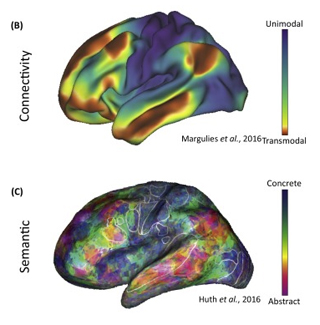Tuesday, 4 September 2018
Cortical Gradients (bis)

As promised in my last post, I’m going to talk a bit more today about an article entitled “Large-Scale Gradients in Human Cortical Organization” that appeared in the journal Trends in Cognitive Sciences (TiCS) in January 2018,
In that last post, I described how the gradient from the more unimodal parts of the cortex (the primary sensory areas) to the more multimodal parts (the more associative ones) provides insight into the organization of large functional networks in the brain, such as the default mode network, which lies at multimodal end of this gradient.
The article in TiCS describes the many observations that led to the identification of this gradient (and of a second one among the various sensorimotor areas) and suggests that it was an important step beyond traditional approaches to mapping the brain. As brain imaging methods have become more and more advanced, it has become possible to produce maps of the various properties of various areas of the brain with unequalled precision. Even so, the way that the elaborate cognitive functions of our brains emerge from the complex geography of these areas is still very poorly understood. And it is this essential question of the general organization of the various parts of the cortex that is addressed by the authors of this article.
The concept of gradients is central to what these authors are proposing. What is that? Well, first the article reviews various characteristics of the brain areas that have already been mapped in detail. I’ll refer you to the article (and in particular, to its Figure 1, part of which is reproduced above) for the definitions of each of these characteristics, but examples include the degree of myelination of the axons, the type of connectivity (to unimodal or multimodal areas), the concreteness or abstractness of the semantic representations, and the duration of the stimuli to which the neurons in a given area are most sensitive.
As the authors describe, for each of these characteristics, a gradient can be discerned in the way that the cortex is organized. In other words, the areas that have similar characteristics are close to one another, and the gradient extends across the surface of the cortex, from the areas that have the least of each characteristic to the areas that have the most. But the most striking thing that the authors observed is that when the gradients for all of these characteristics are superimposed onto the actual anatomical structure of the cortex, with its many grooves and ridges, they align very strongly in the same direction!
This finding is far more informative than attempts to apply traditional functional labels to areas of the brain whose spatial arrangement is often quite confusing. Instead of a map based on traditional functional or anatomical references (such as the rostro-caudal axis), the authors’ map uses references that are intrinsic to the actual cellular architecture of the brain (and consequently closer to the development and expression of the genes that resulted in this particular cell architecture. It’s a bit like discovering your family tree for the first tiime.
In the new light shed by the authors’ description of these two large-scale gradients, the position of a particular area on the surface of the cortex thus no longer appears to be random, but instead can be seen to be driven by an intrinsic developmental logic. These authors were not the first to investigate this promising new approach, and no doubt others will follow them. But we can already see the rough outlines of something that could finally take us further than the repeated attempts to associate brain functions with brain regions or brain networks in an effort to explain how our cognitive abilities may emerge from the particular arrangement of this complex patchwork of cortical areas with their varied characteristics.







